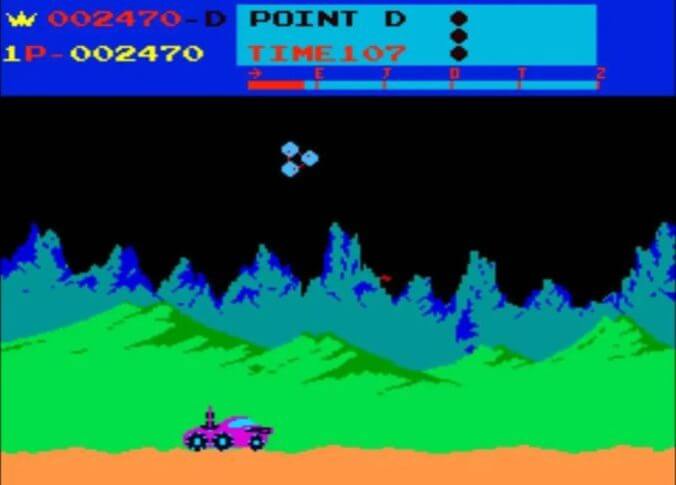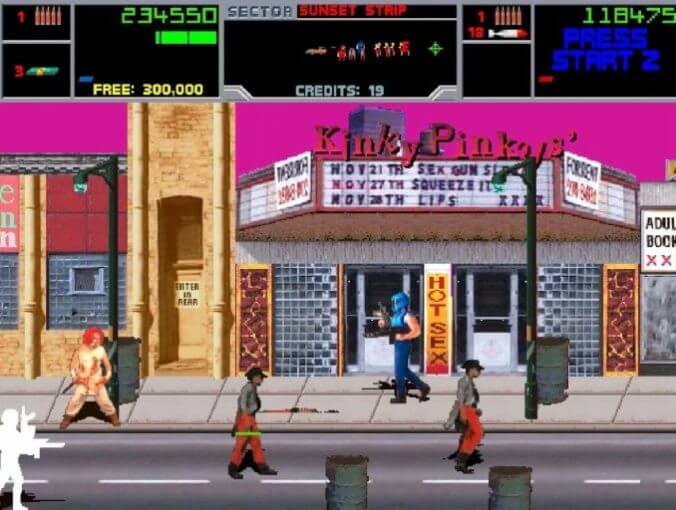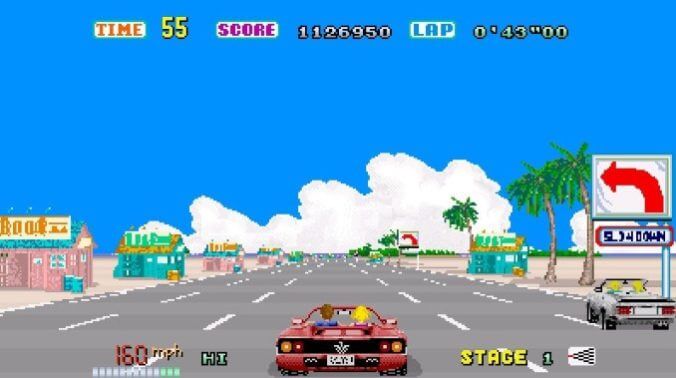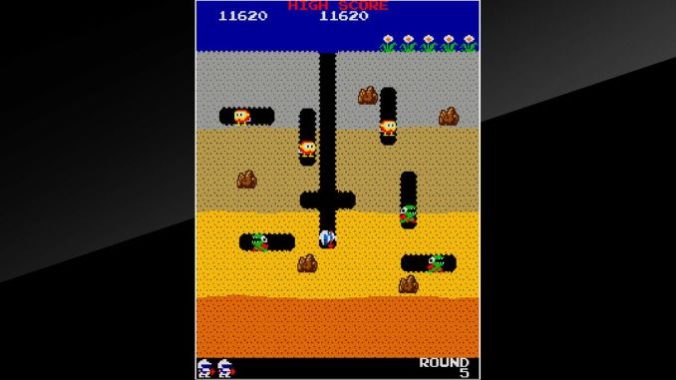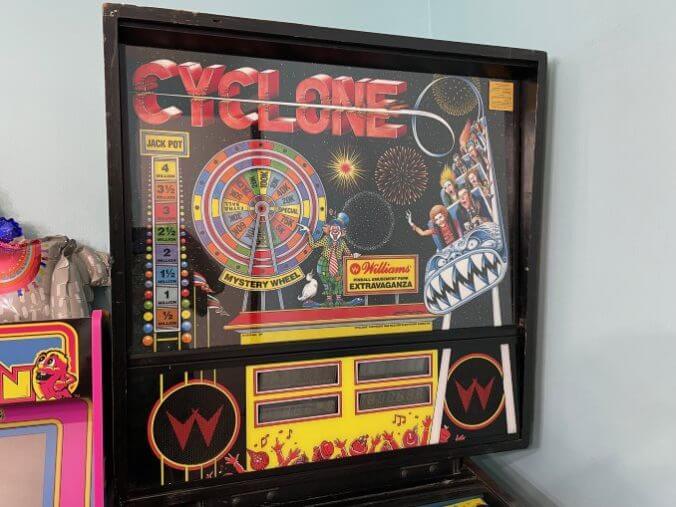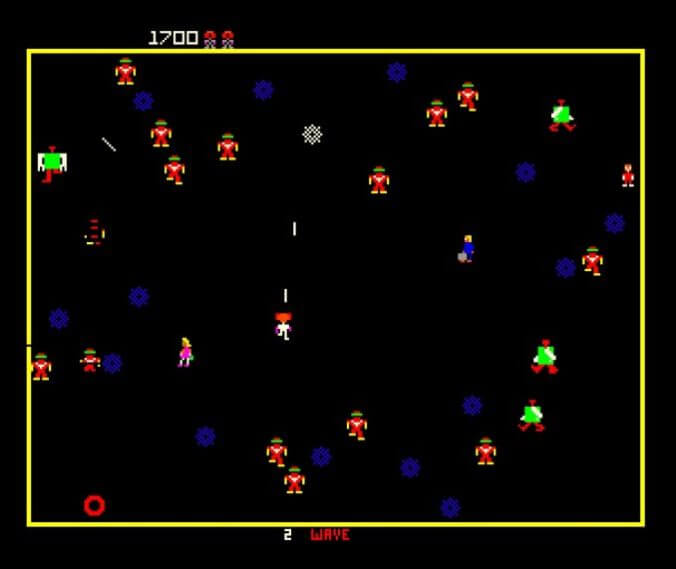Save Your Quarters for These 12 Arcade Bangers for Whenever You’re Trapped in a Bowling Alley in the Early 1990s
Where parents drown their dreams in pitchers of lukewarm Michelob, and a hundred screaming children play chicken with the threat of crush injuries and food poisoning, mankind will find a place to put arcade games. These are the best.
Bowling alley photo from Unsplash. Black Knight 2000 photo by Frédéric Bisson, used under CC by 2.0 deed. Cyclone photo by Garrett Martin.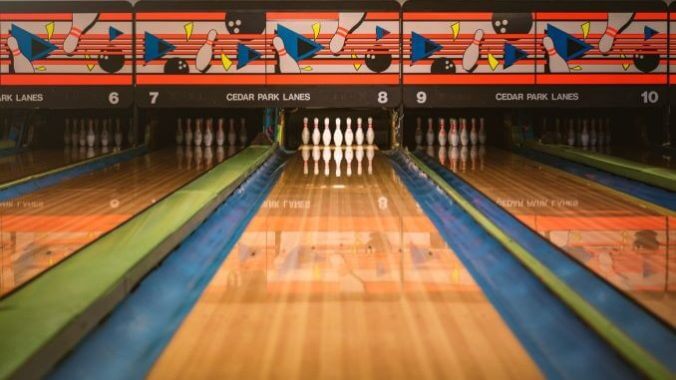
Bowling alleys will always be weird to me. Like the long low shots of tumbleweeds panning through dead clapboard towns in Westerns before all hell breaks loose as everyone kicks out windows and starts going ripshit with Winchester 1873s and Remington 1858s. I’ve been turned away from bowling alleys empty save for the monastic leaguers who demanded a hermetically sealed and silent space to slam balls into pins, and other times I couldn’t escape the convergence of multiple school districts worth of screaming norovirus-shedding children. No other business seemed to vacillate so wildly between the precipice of absolute financial ruin and a cacophonous overabundance. But that’s the prerogative of empire, right?
Bowling may have begun taking shape millennia ago in far-off countries, but few things feel as hideously American as the bowling alley. Since their proliferation in the early 19th century, bowling alleys were quick to draw the ire of busybodies, clergy, politicians, and the frustrated wives who saw them as little more than parlors for boozing, whoring, and general masculine mischief. Taking the carefree frivolity of the outdoor pastime from German immigrants, and ramming it through the corpuscular American identity, bowling became a thick-necked gentleman’s club. How anyone ever thought it was a good idea to combine sport based on the kinetic potential of heavy objects with waxed floors, alcohol, and bare-knuckle, handlebar bravado is beyond me. But much of the early life of the American bowling alley seems like a war between men wanting their jollies and everyone else wanting them to get their shit together.
Eventually bowling got organized, became a real sport, and before too long beer companies started sponsoring teams. Nothing will insulate you but also forever limit you like a beer company slapping their seal of approval up and down your hobby.
Much to the annoyance of real ass professional, semi-professional, and dedicated amateur (meaning “for the love of”) bowlers, what chance to become proper sporting dens was about to be shot to hell when children and families invaded.
Commercial bowling lanes offered something that Chuck E. Cheese could not. A space for adults to drink heavily, eat reflux-inducing food, and have their children become someone else’s problem for a couple hours—but without the obnoxious kid shit.
Bowling alleys were a harbor in a world full of 1980s and ‘90s hellscapes that catered towards (and insisted on) being a present yuppie in your child’s lives. But here, you could be a dutiful parent with a degree of separation, throw a successful birthday party for your spawn and his shitty friends, and no animatronic fucking rodent was going to spring to life and sing at you while you were just trying to enjoy a rapidly-warming Coors Light. No, if a child’s birthday party had to be contained in a public space, this was preferable to many of the alternatives.
I never liked bowling. I also hated other kids’ birthday parties (to be fair, I didn’t like my own birthday parties much either). But there was a time when the bowling alley was its own thing of mystery and potential. It was the last bastion of a defeated and weakened single father who had absolutely run out of ideas. Bowling was so much cheaper than a trip to Kings Dominion, after all. And when every summer blockbuster had been seen, and there were no more B-2 Liberators or diorama kits of miniature Waffen-SS being crushed by the terrifying might of a Revell plastic M4 Sherman tank still oozing Testor model cement, there was Sunset Lanes, or Bowl-a-Rama, or whatever the latest, desperate attempt at a successful bowling alley rebrand called itself. While fever-dream cutscenes that played during strikes always delighted me, bowling was always too loud, too slow, and too haphazard an activity for me to care about. But if there’s one thing I love, it’s an arcade. Good or bad, they’re always interesting; like an Arthurian king and his land, they always find a way to reflect and inform the spaces they exist in. Bowling alley arcades weren’t a main attraction. While they brought in some money, they didn’t bring in as much as warm beer, lousy pizza, and shoe rentals. Between budget constraints, and an inconsistent level of interest and care, the videogame alcove of your local bowling establishment was a wild card of the past, present, and deeply discounted. And if I’m honest, for this reason, I will always cherish them more than even some of the best dedicated arcades.
So, if you should find yourself trapped in a 1990s bowling alley, and you just can’t bring yourself to put your hands in someone else’s ball holes, don’t worry. I got you. Check the pay phone coin returns, shakedown a distracted and buzzed parent, and go sink some quarters into these bangers.
12. Smash TV
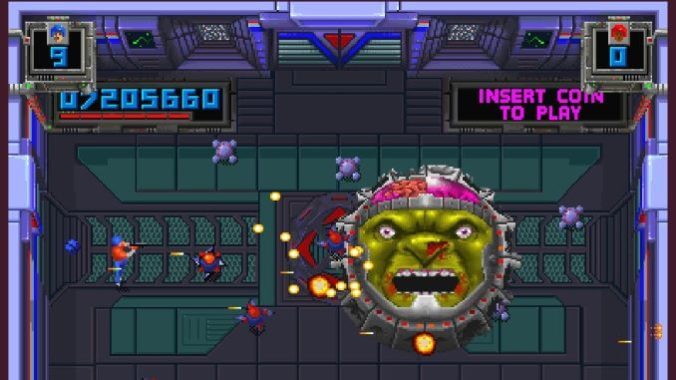
Of all the games veteran game designer Eugene Jarvis made with Williams, Smash TV is arguably the worst. But that doesn’t mean it’s without its charms.
Whenever there’s a nightmare pizza party, this twin stick shooter is bound to be a hot commodity. Guns, blood, and money: Smash TV is a post-Running Man, pre-Squid Game murder and cash grab simulator that turns the mechanics from Eugene Jarvis’ early Robotron 2084 into a cynical hellscape of the future of America (it’s set in 1999).
While I’d never in a million years rate Smash TV over its simpler, more compelling ancestor, there is something burned into the American psyche that responds in a salivating, Pavlovian way when told “kill mfs, get cash.” Smash TV understands this and capitalizes on it. I’ve seen preteen boys go full Bill Laimbeer over who gets to play this first.
11. Pit-Fighter
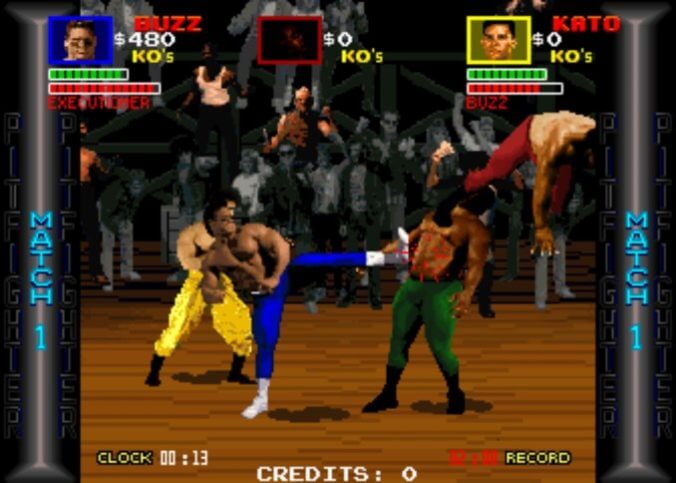
Sure, I’ll bet your bowling alley had a Street Fighter II Champion Edition cabinet, maybe Mortal Kombat, or even Tekken! But those have nothing on Atari’s monstrosity made with digitized footage of real actors.
Two years before Shang Tsung would descend upon the world, what it lacked in Fatalities, it made up for in three-player moxie and a 25″ screen (look, this was a big deal at the time) with a camera that panned and zoomed around to follow the flow of action. True to its brutal, backroom vision of martial arts, there was none of the finesse and skill that Street Fighter required. As Warren Zevon once sang, “the name of the game is be hit and hit back.”
Pit-Fighter had none of the smoothness or comic book cool of other fighters then or since. It only had three buttons, and if I’m honest, it looked ugly, even then. What if sprites could be the embodiment of squiggly cauliflower ear? But also had burly guys beating it out for cash?. What more could you ask for?
10. Spy Hunter
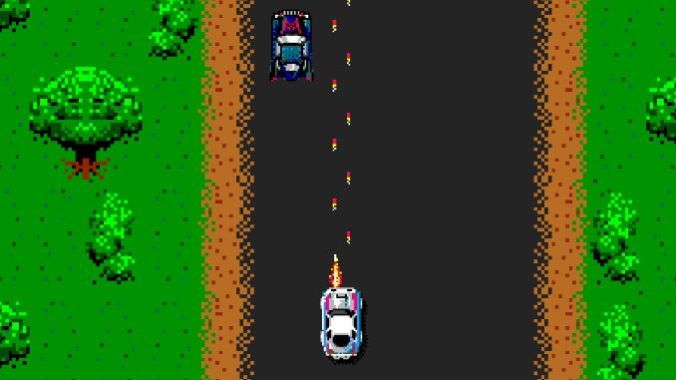
It almost was a James Bond arcade game, but when the licensing deal fell through the Aston Martin got turned into some kind of nightmare hybrid between a DMC DeLorean and a Ferrari Testarossa with just a hint of Countach (truly ‘80s was an automotive hellscape at times), and the game picked up a chiptune version of Henry Mancini’s Peter Gunn theme that looped endlessly until you simply ran out of lives in this otherwise endless vehicular shooter.
Rear-mounted oil slick ejectors to make your rivals spin out of control. Dual front-fire machine guns with great range to mow-down enemy cars rather than avoid them. Surface-to-air missiles for when some Tiger-Heli looking mf decides to show up and ruin your day. This car had it all, even a smoke screen! In certain stretches, the game lets you enter a boathouse and turn into a speedboat with a flamethrower instead of oil slicks as you cruise down intercoastal waterways towards no destination in particular. The endless drive of machine guns, chiptune horns, and a singular pulsing guitar riff.
While they should have swung entirely the other way and given us Frank Lupo’s inimitable ‘80s TV series, Hunter, complete with Fred Dryer and Stepfanie Kramer art slapped on the side of the cabinet, I’ll forgive them because this vertical scrolling cart shooter is the right kind of satisfying an American scrolling shooter can provide. 1942 and Legendary Wings and the like required concentration. UN Squadron would soundly beat your ass, and the soundtrack went too hard to let itself be washed out in the cacophony of balls, pins, and children screaming. Sure, it required balancing the yoke-like steering wheel, a gear shift, an accelerator pedal, and buttons for regular and special weapons. But Spy Hunter is still a game where you could crush the leaderboard while eating a slice of room-temperature punishment pizza.
9. Operation Wolf
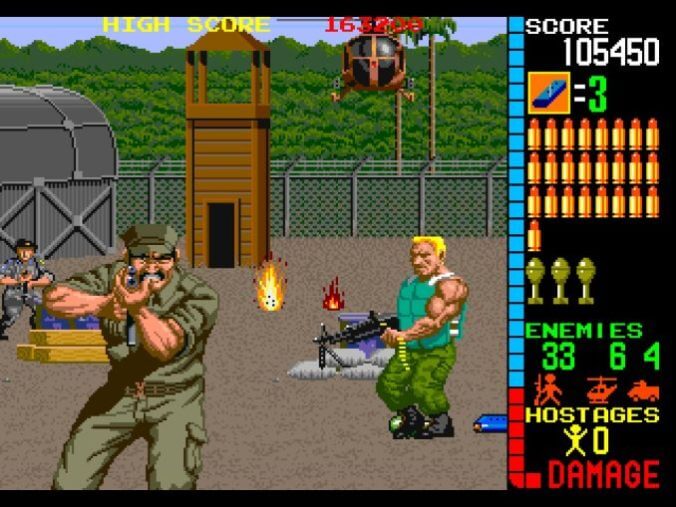
In 1995, Flux Magazine declared Terminator 2: Judgment Day to be “the current gun-game standard.” And sure, it may have been that. But the average bowling alley was not spending the kind of money on an arcade cabinet that would get you a four-year-old, blockbuster movie tie-in from Midway. No. You weren’t even going to get Operation Thunderbolt with its dual machine guns unless you were extremely lucky or at one of those fancy AMF establishments in the nice suburbs. Bowling alleys had arcades, but they were side-shows to the main event of waxed lanes, heavy balls, and dads drinking beer while narrowly avoiding crush injuries.
By the time it hit your local bowling alley, even the Operation Wolf console port was old and had spawned much more capable sequels, but in this chaotic afterthought of an arcade it had lost none of its potency. Taito’s original single-player, arcade light gun shooter was an instant classic with a single, vibrating Uzi-like emplacement. No more cartoon ducks or the tin cans and weirdos from Hogan’s Alley. These were Real Dudes who shot at you. Right at YOU. You could look them right in their pixelated faces, glaring down the iron sights, and immediately chip a tooth as the simulated recoil rocketed the metal gun right into your mouth with a tremendous amount of poorly maintained kick. Unlike most light gun shooters that simply ended abruptly when you sustained too much damage, Operation Wolf announced that you had sustained a lethal injury, but it also would abruptly end if you mismanaged your ammo by either gunning too aggressively or failing to pick up more magazines. It was a clever and frustrating mechanic to balance on top of simply not dying, and like the “you are finished here” text from the death screen, the image of the player character withering away in prison as the game taunts “Since you have no ammunition, you must join the hostages” felt like a taunt to put one more quarter in as a small rebellious middle finger against the game.
Inevitably, there was some jingoistic dad who hadn’t let go of the Cold War and had seated his nightmare toddler astride the gun emplacement. “Get those Roos-kies!” he’d cheer as if it was some kind of Red Dawn simulator/anti-communist operant conditioning experiment. Inevitably the child would burst into tears. A mother would yell. And the machine would be yours until people started screaming at you to bowl.
8. Black Knight 2000
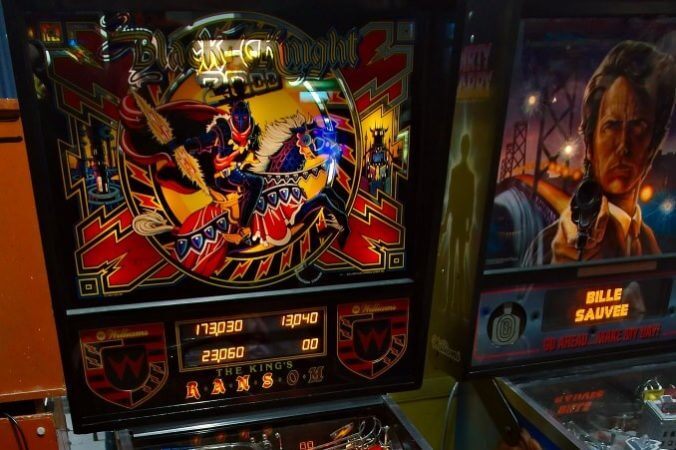
“Black Knight 2000 launches you into the ’90s with a Steve Ritchie masterpiece that’s fast but friendly,” is how Williams sold this beautiful, easy to understand, and immediately dated-looking piece of machinery.
Where your average arcade might get a wall of pinball machines, bowling alleys rarely had the room for something that took up so much floor space (that was reserved for our #1 entry). You got one pinball game, usually disused, dejected, but surprisingly in good shape because the Nightmare Children of the Bowling Alley Birthday Party wouldn’t be caught dead putting money in one of these. Especially not something that looked like a ‘70s British metal band album cover.
Heathens.
Sure, Black Knight 2000 wasn’t the best seller that the original Black Knight was, but it was as solid a gateway into pinball as any. Simple enough to learn the basics of scoring, with a playfield that was lively and chaotic. I couldn’t tell you who veteran pinball designer (and then-future voice of Shao Khan) Steve Ritchie was in 1989 when I first wrapped my grubby hands around the front of this machine, but you can feel the “Master of Flow” at work here all the same. You could also be sure it was always never going to be more than one quarter, and your playtimes would last way longer than playing Mortal Kombat against high school seniors.
